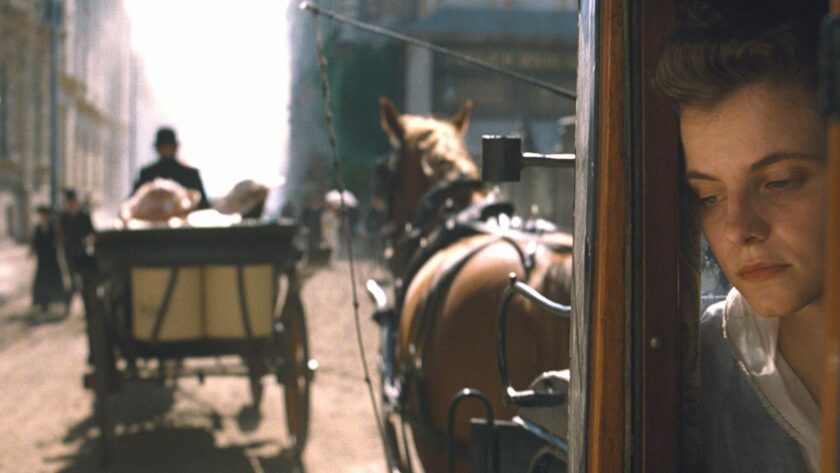It’s festival season! The FilmSoc blog is covering the 75th Venice International Film Festival (29 August – 8 September), diving into the myriad of films and events on offer to deliver reviews.
Milo Garner appreciates ‘Son of Saul’ director László Nemes’ latest drama.
Like a river running ceaselessly, Sunset (Napszállta) is insatiable. It flows and rushes and crashes with grace and ferocity, rushing into the black, seeking its conclusion with dextrous élan. Son of Saul was a deeply impressive debut from László Nemes, exhibiting a fully formed style and exquisite method – he realises that the best way to emphasise the unshowable is to do just that, keep it from vision. His camera was locked to Saul’s back, a wide frame just revealing hints of the horrors beyond, leaving their detail to the mind of the viewer. Sunset proceeds in a similar vein, but one yet more sophisticated, finding for this form a narrative that fully complements it – one that makes emphatic the unseen, the unknown, the unthinkable.
The film opens in Budapest, sometime in the early 1910s. This is a civilisation on the brink of non-existence, the last gasp for one of Europe’s most illustrious – but least represented – empires. In less than a decade the empire would be strewn asunder in the rubble of the First World War, its wealth and magnitude quickly a forgotten memory; Nemes has created an atmosphere of apocalypse, but one that only seeps from the edges. His Budapest is defined by its extremes – secret societies of both low and high class whisper in the dark corners, poor workmen toil away outside luxury stores, secrets linger on every tongue. He does not present this downfall in a political or even pointedly social manner, preferring instead to evince a tone, a rhythm of decline. It would be difficult to describe what exactly is wrong with Sunset’s Budapest, but it always seems askew, always awry.

The film’s opening shot introduces us to Irisz Leiter, veiled and unknown. She is the orphaned daughter of the man who once owned an exclusive hat shop in central Budapest, one that still bears her family name, and so travels there to take up employment. She is treated with suspicion and without reason sent away, though she refuses to leave the city. News reaches her ear that she might have a brother, but this fact, initially denied, is itself cloaked in yet more ambiguity and ambivalence. This is the mode in which Nemes reveals his narrative, every fact and detail questioned and obscured, a mystery in which everyone seems a complicit agent. The battle lines have been scuffed and hidden, but they lie there still, awaiting definition. Leiter rattles the cage, delving further into an ignored past, enlivening a flame thought cold.
This narrative of obfuscation is compelling, and is matched by a protagonist who drives the plot against any risk of needless obscurity or confusion. Almost every conversation, every decision, every movement or event in the film is at some point interrupted or disturbed. Characters on the verge of revelation will be distracted and pulled away, decisions made will suddenly be reversed, and most consistently will Leiter reject the reality assigned to her. Constantly she will be detained by word or force and in some way resist, constantly she will contradict what might be the expectant direction of the narrative. Instead she is a driving force, forcing a momentum, never supplicant or pathetic. This is a film that never rests, refusing to take any time to reconcile so much as push ever on. In this way, it reflects less a period piece than it does a thriller, unrelenting and exhilarating.
This narrative force is matched and encouraged by Nemes’ formal direction. Maintaining a similar camera to Son of Saul, his lens is often close to Leiter’s back, her body obscuring most of the frame. She is often in motion with the camera maintaining the frame, letting detail slip in from the sides, often out of focus. Her alienation is felt texturally, the mystery is encompassing. This motion also figures into the pace of the film, conversations often taking place with extensive blocking, characters always busy elsewhere, or concerned with some other thing. Leiter’s interruption, and our observance, is very much incidental to the scenario.

This close eye on motion also delves into more specific formal territory, such as Leiter only ever coming into frame from left to right. In western writing this is the direction of progression, of forward movement. It also bears comparison to Agnes Varda’s Vagabond, in which its protagonist is notably caught in traversals that move from right to left. Where Varda’s wanderer, equally isolated in her way, is attempting to escape society, Leiter seeks to probe its hidden depths, implicate herself directly. The deeper she burrows the further her supposed neutrality is questioned, but Nemes always presents her as someone who acts in accordance to herself, not a supposed or genetic allegiance of any kind. Budapest continually reveals itself to be a city built on opposing fronts, but Leiter refuses to directly identify with either, preferring instead to tread the path that encompasses her own conception of justice or truth.
The camera’s closeness to Leiter also results in an immediacy to proceedings, as already essential to the film’s narrative progression. Leiter is centred in every scene, the camera never leaving her for long in the rare cases that it does. This attachment courts tension; any moment of danger becomes doubly unsettling for the knowledge that there is nowhere else the camera can or will cut. We are trapped with Leiter, and must remain at her side as her environments become ever more threatening; even spaces deemed safe take on a sinister tenor. Coupled with Leiter’s tendency to the bold and brash, Sunset almost enters the realm of horror cinema, a descent into unravelling chaos and destruction. The raid of an estate becomes intimate through Leiter’s eyes, and her inherent vulnerability forces what could be a minor event in a more distanced film into being a deeply unsettling set piece.

But most astounding is how Nemes maintains this formal and narrative excellence throughout. Never does the plot slacken, never is attention lost. This is a film of forward motion, progressive momentum, intimacy; and at once also serves as a metaphorical telling of a civilisation crumbling under its own weight. It shines with the glint of Europe’s finest cinema: it has beautifully rich colours, pristine close photography, a cutting string soundtrack. But then, I also feel that one of its closest companions, besides Son of Saul and some nods to the like of Béla Tarr, is Mad Max: Fury Road. A bizarre, even facetious comparison that might initially seem, but they both engage in a similar cinematic mode. They both create scenes of extended and inescapable tension, emphasised by constant motion, constant interruption, constant development in stakes. Fury Road might be more physical than Sunset, but much of their success relies on the same principles, albeit through two very different lenses.
I make that comparison from more than a theoretical position but an emotional one. They both imbued in me a thrill and a levity, a certain disbelief at what I was witnessing. They are not intellectual– though they do find intellectual footfall – but rather experiential, functioning best as a direct cinematic force. This is cinema that cannot be written down, cinema that is explicitly visual and aural. The sculpting of time, which for some films can be incidental, or of middling importance, is here paramount – every moment is justified, every cut reasoned; a story that in some other manner might come across as trite or limited is here elevated to the inimitable. Sunset is the beautiful rush, a confluence of vision and ability so rarely found, and so sweetly savoured.
10/10
Sunset will premiere at the BFI London Film Festival on October 15th. Take a look at its trailer below:




